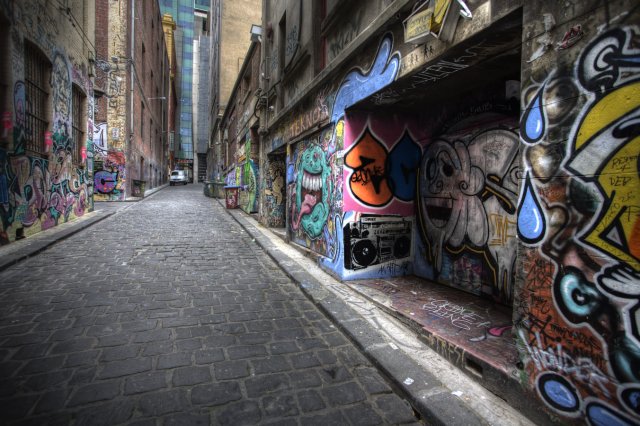
Increased evidence of homelessness in Melbourne’s iconic graffiti laneway, Hosier Lane, has prompted outrage from government and local businesses in recent weeks.
After a number of negative media reports, homeless people are subtly being displaced. Businesses are boarding up alcoves. Police are patrolling and making arrests.
Recently described as a “drug den”, it seems the colourful lane is losing its sheen. “It’s just become a joke,” says the owner of MoVida, a popular tapas restaurant that shares the laneway with the public. He says people shooting up, performing oral sex on each other and spitting at tourists is bad for business.
Aura of crime pays
Despite Victoria Police Inspector Trevor Cornwill declaring “it is not illegal to be homeless”, it appears that the presence of homelessness in this public space is.
Recently, the alcoves that are the only sheltered space in the laneway were boarded up, effectively extinguishing the use-value of that space for homeless people. People were filmed being put into the back of paddy wagons and the number of rough sleepers in the lane has decreased.
Temporarily displacing the problem from a tourist hotspot, the vulnerability of these people remains, yet in less visible places. In asking why homeless people are here, we should also ask why is MoVida here, why are the tourists here, why do wedding groups pose for photos every weekend?
Yes indeed: it is the graffiti; the atmosphere; it is the spectacle of edginess.
Graffiti is generally illegal in Victoria. Nationwide, it costs the taxpayer around $200 million a year to remove it.
Most of those who practise graffiti art occupy the fringe of society, a subculture that reshapes the order and image of public space. They stage confrontations with the norm, filling in the gaps of urban space. And we value them — so much so that it is desirable to be near their work, a marketable part of the city.
It is hip to be near the edge. The renewal of urban space often tries to incorporate alternative culture. We now pay graffiti artists to paint our public spaces.
Edginess is sellable and the commercialisation of Hosier Lane relies on its nearness to this edge. The aura of crime — an in-between space relying on a status of not quite lawful, not quite orderly — is highly desirable.
Whose public space is it?
In Hosier Lane we are seeing the use-value of public space eradicated. Public space is being enclosed and popular media representations of homeless people are facilitating this. Commercial interests are determining who can and can not dwell and pass through the public places of the city — a case of profits over people.
An interesting contradiction is how public lives are being criminalised, while the very aspect of public space that we value is based upon a proximity to criminality.
Surveillance, arrests, media smearing, business outcry and the boarding up of alcoves: this demonstrates how we create workarounds in order to further persecute marginalised people in our cities. Yet marginal practices such as graffiti are brought to the centre of our identity; we embrace graffiti’s criminal aura and its potential to create life out of decay.
Homelessness is confronting and, yes, there have been confrontations in Hosier Lane. This gives us a prime opportunity to engage in politics from all social positions.
We all have a right to this city — it is based upon our shared ability and capacity to shape public space. When the order of public space is dictated, ordered and made rigid, it loses its ability to facilitate politics.
A right to the city
Graffiti no longer sets up a disagreement over the use of public space, at least not graffiti that helps sell the city.
Homelessness in Hosier Lane is the staging of a disagreement that graffiti once did, but no longer does. It is not just an argument over the growing rate of homelessness in the city, the housing crisis and the appropriation of alternative culture. It is fundamentally an argument over the order and control of public space.
There are tensions in the use and exchange value ascribed to public space. Not only are homeless lives being denied a right to the city, all rights to the city are threatened when public space is enclosed.
[David Kelly is a PhD candidate at Alfred Deakin Institute for Citizenship and Globalisation, Deakin University. This article was originally published on The Conversation.]
Like the article? Subscribe to Green Left now! You can also like us on Facebook and follow us on Twitter.